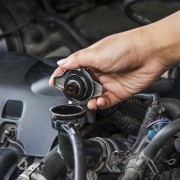Heading into a Canadian winter can be daunting for drivers. Freezing temperatures often lead to deflated tires, frozen brake fluid, and other complications. Good preparation can prevent your car from breaking down and save you money over time. Is your vehicle ready for winter driving? We’ve gathered some simple but crucial maintenance tips to help you prepare your car for winter and cruise on through the season.
- Browse Categories
- All Tips
-
Home & Garden
- All
- Appliances
- Bathroom
- Cleaning
- Crafts
- Decorating
- Electrical
- Flooring
- Furniture
- Garage Door
- Gardening
- Green Living
- Heating
- Home Alarm Systems
- Home Maintenance
- Home Remedies
- Home Security
- Home Staging
- House Sitting
- Junk Removal
- Kitchen
- Lawn Care
- Lock Systems
- Moving
- Outdoor Living
- Pest Control
- Plumbing
- Renovation
- Roofing
- Snow Removal
- Storage
- Tools
- Tree Service
- Health
- Family
- Travel
- Auto
- More Tips

How to prepare your car for winter driving
By Kevin , September 27, 2021

[Photo Credit: Drobot Dean]
1. Install winter tires
First, you’ll want to find some winter-approved tires–and yes, you need all four–with tread no less than 3.5 mm. All-season tires won’t cut it. Winter tires improve traction in snowy and icy conditions–this is critical if you want to prepare your car for a snowstorm. Even if you already have winter tires, you may want the help of an auto technician to check the wear and air pressure before driving. The cold air can cause deflation, which will degrade your traction and make it harder to control the vehicle.
________________________________________________________________
Ready to get your vehicle checked out for winter safety?
Let YP help you find your neighbourhood Automotive Repair centre.
________________________________________________________________
2. Change your wipers
Maintaining a clear line of vision is critical for winter driving. Wiper blades — regardless of type — only last for 6 months to a year, so it’s important to switch them out often. A proper winter wiper blade is more heavy-duty and can resist frost and precipitation better. After installing new wipers, be sure to spray a lubricant at the base of the wiper arm where it bends to keep it moving smoothly.
3. Test your car battery
The last thing you want on a cold day is to get stranded with a dead battery. When temperatures drop below freezing, your battery works extra hard to keep your car running. It’s wise to go into your local automotive shop to get a battery test early on. The test is quick and is often included when you purchase a seasonal maintenance check-up.
4. Refresh your oil
Your vehicle’s fluids keep it running smoothly without exerting too much energy. See your neighbourhood auto shop to have your oil changed. Cold temperatures cause your car’s oil to thicken and move more sluggishly through the engine. Depending on the make of your vehicle, an expert may recommend using a thinner oil in winter.
5. Stock up on essential supplies
Trouble can arise unexpectedly when out on the roads. Safer winter driving starts with planning for the worst-case scenario. Create a survival kit in case of emergency, with items like a windshield scraper and snow brush to prepare your car for a snowstorm. Pack some battery jumper cables and reflectors or flares in case you need assistance. Stock up on a coolant with a low freeze point, so it can keep flowing even in the most severe conditions. Extra clothes, a blanket, and some non-perishable snacks could come in handy when you least expect it.






